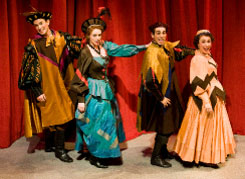Reinventing Child’s Play
A state-of-the-art “natural playground” at the Eliot-Pearson Children’s School delights kids and sparks research on child development
By Marjorie Howard
For adults who grew up with jungle gyms and see-saws, the new playground at the Eliot-Pearson Children’s School won’t bring back childhood memories. Pathways lead to a hill made of boulders; a water pump awaits eager hands. In one corner is a hut; in another, a garden. A wooden ramp leads to a boardwalk that wraps around a tall tree and spirals into its branches, creating the allure of a tree house.

At the new playground at the Eliot-Pearson Children’s School, playing with water is a natural thing to do. Photo: Joanie Tobin
This is what’s called a natural playground, a place where kids can explore. Instead of offering the kind of predictable play that often takes place on standard playground equipment, natural playgrounds provide open-ended, challenging spaces. More common in Europe and on the West Coast, natural playgrounds use native plants, hills, trees and natural materials whenever possible.
At Tufts, the natural playground is also serving as a laboratory for the school’s staff as well as for faculty and students from the Eliot-Pearson Department of Child Development in the School of Arts and Sciences. Undergraduates and graduate students trained to observe children at play are comparing what happens when kids use traditional equipment with what happens on the natural playground. Children were also interviewed about their play in the old and new space.
“When you read about natural playgrounds, it’s very romantic—the kids should be outside and in nature,” says Lisa Kuh, the head teacher at the school and principal co-investigator, with Iris Chin Ponte, a postdoctoral associate, for the research project. “It sounds good, but no one has said why it is good; there is no study on how kids played before and after the natural playgrounds. What makes this wonderful?”
The initial idea was to simply replace an old, rusted play structure. But Debbie LeeKeenan, the school’s director, says that when she and her staff realized the structure was no longer up to building codes, they decided it was time for something different.
“The goal,” she says, “is an environment that supports children’s learning in all the different dimensions, but outside. In the classroom we look at physical, creative, cognitive, language and social and emotional development. We think about those things when we create a classroom for children, and we think that should be just as important outside as inside.”
Hoping for Messiness
Last fall LeeKeenan and her staff consulted with designer Rusty Keeler, whose New York company EarthPlay designs what are called playscapes. He met with the school’s students, teachers and parents to learn what they most wanted. The school community, including its 80 children, ages three through eight, made it clear that water would be an important ingredient for any new playground.
So the water pump was installed, along with a kind of waterfall: push a button and water comes cascading down some boulders on a small hillside into a large sandpit at the bottom. Kids build channels in the sand to direct the water or gleefully smear wet sand around. Some send homemade boats down the boulders.
In another corner is the Hobbit House, an open wood structure built and designed by teacher Caitlin Malloy, G11, and her father, Doug. The house allows kids to hide but still be seen by adults. Several paths, with changing surfaces of bricks, dirt, sand or rubber, invite tricycle riders. Yet another area has a raised-bed garden, log benches and a wildflower meadow. The research study on whether children play differently in such an environment is already well under way. The first phase, done on the old playground, has been completed, and the second phase is going on now in the new playground. While the children play, they are being closely observed, and those observations are supplemented by interviews with both the children and their teachers.
“The undergraduates are getting real hands-on experience with research,” says Kuh. They’re trained to follow a particular child and check off what the child does and where he or she is in the playground every 30 seconds for 36 different kinds of activities. They also watch for parallel play, in which children play side-by-side; associative play, in which they may share materials but not necessarily play together; and cooperative play, in which they play together.
“We want the children to engage in cooperative, constructive play. Will this playground promote that?” Kuh asks. She hopes the study will help other schools and programs make decisions about their own playgrounds.
“Not every single school has to build this, but as teachers and researchers we want to pull out what elements of this design are most important,” she says. That way, each playground can be built to best suit a particular community. The Eliot-Pearson playground cost about $150,000, with money coming from the school’s fundraising efforts and from the School of Arts and Sciences.
But as far as the kids are concerned, it’s all fun. LeeKeenan notes that around the corner from the natural playground is an older playground with a typical play structure, one the school decided to keep. She says fewer kids are using it these days. And she doesn’t mind, even if it could mean more work for her and her staff. In the new space, which has two areas for water play—the boulders on the hill and the water pump—she’s asked if the kids will get messy.
“We hope so,” she responds.
Marjorie Howard can be reached at marjorie.howard@tufts.edu.

